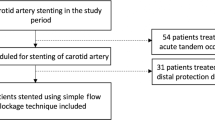Abstract
Background
Carotid artery stenting (CAS) with proximal occlusion effectively prevent distal cerebral embolism by flow arrest at internal carotid artery (ICA); however, the method can expose antegrade flow at ICA due to incomplete flow arrest. The aim of this study was to identify predictors of antegrade flow during CAS with proximal protection.
Methods
We retrospectively analyzed clinical and angiographic data among 143 lesions treated with CAS with proximal protection by occluding the common carotid artery (CCA) and external carotid artery (ECA). Flow arrest or antegrade flow at ICA was confirmed by contrast injection during proximal protection.
Results
Antegrade flow at ICA was observed in 12 lesions (8.4%). Compared with lesions in which flow arrest of ICA was achieved, the diameter of the superior thyroid artery (STA) was significantly larger (2.4 ± 0.34 vs. 1.4 ± 0.68 mm, p < 0.001), and the rate of ECA branches other than the STA located 0–10 mm above the bifurcation was significantly higher (50 vs. 8.4%, p < 0.001). Results of multivariate analysis revealed that a diameter of the STA ≥ 2.3 mm (OR 44, 95% CI 8.1–237; p < 0.001) and ECA branches other than the STA located 0–10 mm above the bifurcation (OR 6.0, 95% CI 1.1–32; p = 0.036) were independent predictors of antegrade flow.
Conclusions
Distal filter protection should be combined with proximal protection for the lesions with antegrade flow to prevent distal migration of the carotid debris.



Similar content being viewed by others
Abbreviations
- CAS:
-
Carotid artery stenting
- ICA:
-
Internal carotid artery
- CCA:
-
Common carotid artery
- ECA:
-
External carotid artery
- STA:
-
Superior thyroid artery
- EPD:
-
Embolic protection device
- MRI:
-
Magnetic resonance imaging
- T1W:
-
T1 weighted
- rSI:
-
Relative signal intensity
- LA:
-
Lingual artery
- FA:
-
Facial artery
- OA:
-
Occipital artery
- ROC:
-
Receiver-operating characteristic
References
Acar M, Salbacak A, Sakarya ME, Zararsiz I, Ulusoy M (2013) The morphometrical analysis of the external carotid artery and its branches with multidetector computerized tomography angiography technique. Int J Morphol 31:1407–1414
Cassese S, Ndrepepa G, King LA, Nerad M, Schunkert H, Kastrati A, Ott I, FUsaro M (2015) Proximal occlusion versus distal filter for cerebral protection during carotid stenting: updated meta-analysis of randomised and observational MRI studies. EuroIntervention 11:238–246
Cavalcanti DD, Reis CV, Hanel R, Safavi-Abbasi S, Deshmukh P, Spetzler RF, Preul MC (2009) The ascending pharyngeal artery and its relevance for neurosurgical and endovascular procedures. Neurosurgery 65(Suppl):114–120
Fazan VP, da Silva JH, Borges CT, Ribeiro RA, Caetano AG, Filho OA (2009) An anatomical study on the lingual–facial trunk. Surg Radiol Anat 31:267–270
Giugliano G, Stabile E, Biamino G, Petroni G, Sannino A, Brevetti L, Pucciarelli A, Popusoi G, Tesorio T, Cioppa A, Cota L, Salemme L, Sorropago A, Ausania A, Pietra GD, Fontanelli A, Trimarco B, Esposito G, Bubino P (2014) Predictors of carotid occlusion intolerance during proximal protected carotid arterystenting. JACC Cardiovasc Interv 7:1237–1244
Harada K, Kakumoto K, Morioka J, Saito T, Fukuyama K (2014) Combination of flow reversal and distal filter for cerebral protection during carotid artery stenting. Ann Vasc Surg 28:651–658
Hayashi N, Hori E, Ohtami Y, Ohtani O, Kuwayama N, Endo S (2005) Surgical anatomy of the cervical carotid artery for carotid endarterecromy. Neuro Med Chir (Tokyo) 45:20–30
Klosek SK, Rungruang T (2008) Topography of carotid bifurcation: considerations for neck examination. Surg Radiol Anat 30:383–387
Knappich C, Kuehnl A, Tsantilas P, Schmid S, Breitkreuz T, Kallmayer M, Zimmermann A, Eckstein HH (2017) The use of embolic protection devices is associated with a lower stroke and death rate after carotid stenting. JACC Cardiovasc Interv 10:1257–1265
Lo A, Oehley M, Bartlett A, Adams D, Blyth P, Al-Ali S (2006) Anatomical variations of the common carotid artery bifurcation. ANZ J Surg 76:970–972
Natsis K, Raikos A, Foundos I, Noussios G, Lazaridis N, Njau SN (2011) Superior thyroid artery origin in Caucasian Greeks: a new classification proposal and review of the literature. Clin Anat 24:699–705
Omran J, Mahmud E, White CJ, Aronow HD, Drachman DE, Gray W, Abdullah O, Abu-Fadel M, Firwana B, Mishkel G, Al-Dadah AS (2017) Proximal balloon occlusion versus distal filter protection in carotid artery stenting: a meta-analysis and review of the literature. Catheter Cardiovasc Interv 89:923–931
Ozgur Z, Govsa F, Ozgur T (2008) Assessment of origin characteristics of the front branches of the external carotidartery. J Craniofac Surg 19:1159–1166
Stabile E, Sannino A, Schiattarella GG, Gargiulo G, Toscano E, Brevetti L, Scudiero F, Gingliano G, Perrino C, Trimarco B, Esposito G (2014) Cerebral embolic lesions detected with diffusion-weighted magnetic resonance imaging following carotid artery stenting: a meta-analysis of 8 studies comparing filter cerebral protection and proximal balloon occlusion. JACC Cardiovasc Interv 7:1177–1183
Author information
Authors and Affiliations
Corresponding author
Ethics declarations
Conflict of interest
None.
Ethical approval
For this type of study, formal consent is not required.
Informed consent
Additional informed consent was obtained from all individual participants for whom identifying information is included in this article.
Additional information
Comments
Carotid artery stenting (CAS) with proximal occlusion is theoretically the most effective procedure to prevent distal cerebral embolism by flow arrest at internal carotid artery (ICA). However, existence of antegrade flow at ICA during proximal protection may cause embolic stroke. The authors clearly demonstrated occurrence rate (8.4%) and predictors of the antegrade flow in this interesting report. Additionally, their strategy using distal filter device in addition to proximal balloon protection can prevent distal cerebral embolism even in presence of the antegrade flow. This report is interesting and will give an important information for the readers.
Kenji Sugiu
Okayama, Japan
Rights and permissions
About this article
Cite this article
Harada, K., Kakumoto, K., Oshikata, S. et al. Predictors of antegrade flow at internal carotid artery during carotid artery stenting with proximal protection. Acta Neurochir 160, 1121–1127 (2018). https://doi.org/10.1007/s00701-018-3487-y
Received:
Accepted:
Published:
Issue Date:
DOI: https://doi.org/10.1007/s00701-018-3487-y




